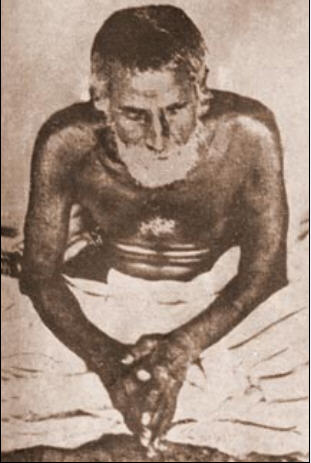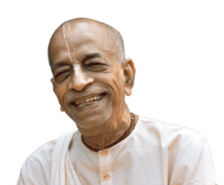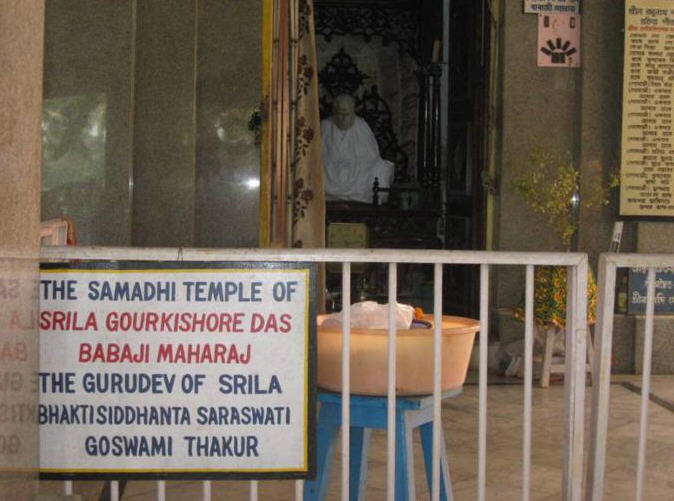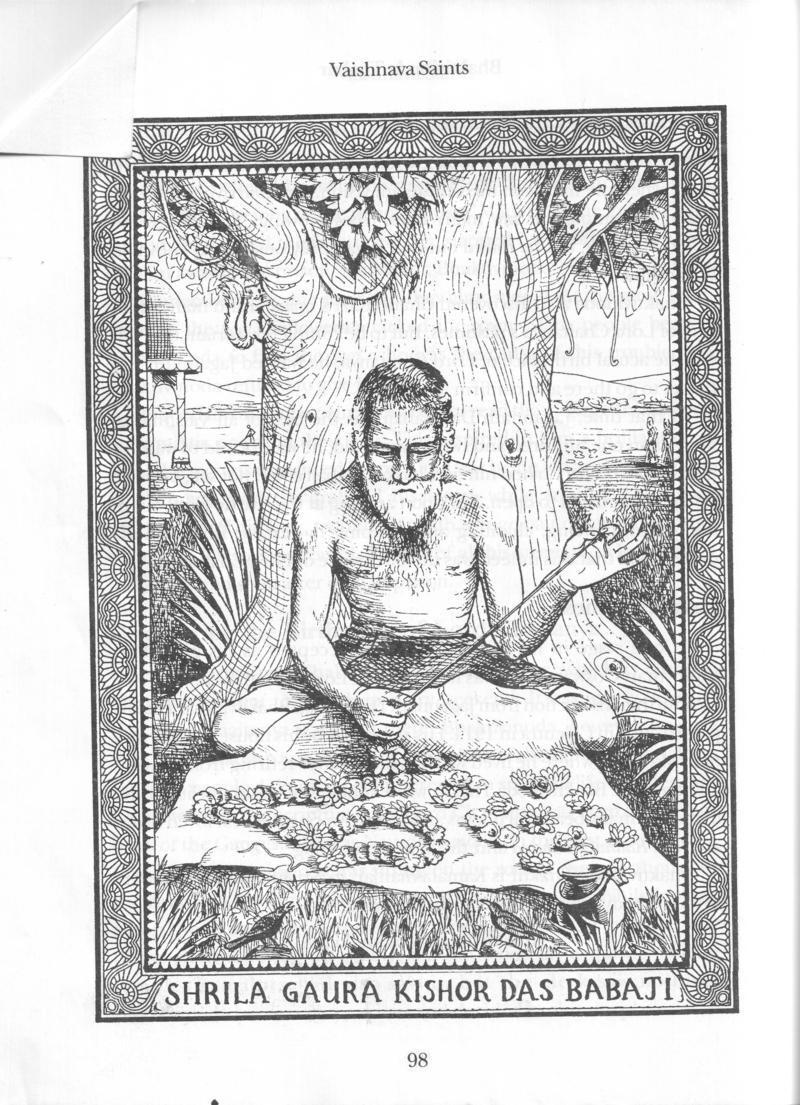
Deprecated: Function create_function() is deprecated in /var/www/wp-content/plugins/wp-spamshield/wp-spamshield.php on line 2033
Thursday, November 10, 2016 – [Los Angeles, California, USA time] EkadasiFriday, November 11, 2015 [Mayapura, West Bengal, India Time] Ekadasi
Srila Prabhupada praises His Guru Maharaja’s guru, the exalted Srila Gaura Kishora dasa babaji
compiled by Yasoda nandana dasa
Indian: Because if we go wholeheartedly to God without proper understanding, there is also a flaw.
Srila Prabhupāda: No. There is no question of understanding. Suppose this process… Just like Kṛṣṇa says, bahūnāṁ janmanām ante jñānavān māṁ prapadyate: [Bg. 7.19] “After many, many births of culture of knowledge, the person who has come to the highest point of knowledge, he surrenders unto Me.” So similarly, if any person without any knowledge, if he surrenders only to Kṛṣṇa, he acquires all the knowledge. He has surpassed all stages. He has surpassed all stages. And that is also confirmed. If you say, “How he has gone, surpassed all stage?” That answer in Bhagavad-gītā you find,
teṣām evānukampārtham
aham ajñāna-jaṁ tamaḥ
nāśayāmy ātma-bhāva-stho
jñāna-dīpena bhāsvatā
[Bg. 10.11]
Teṣām: “Because he is a devotee, just to give, just to show him a special favor,” teṣām evānukampārtham, “simply for showing a special favor, I Myself, from within, I light up the knowledge, I mean to say, searchlight, and he becomes…”
And you will be surprised that my Guru Mahārāja’s spiritual master was Gaura Kiśora dāsa Bābājī Mahārāja. He was completely illiterate. He did not know how to sign, and my spiritual master was the most learned man of his age. He accepted that guru who was completely illiterate. But when he would speak, that Gaura Kiśora dāsa Bābājī Mahārāja, he would speak with all Vedic references. And you will find in the Veda that
yasya deve parā bhaktir
yathā deve tathā gurau
tasyaite kathitā hy arthāḥ
prakāśante mahātmanaḥ
[ŚU 6.23]
So the spiritual knowledge becomes revealed. It is not subjected to any material acquisition. It is not subjected to any material acquisition of knowledge. It becomes revealed. How? Yasya deve parā bhaktir yathā deve tathā gurau. One who has a staunch faith in the Supreme Lord and staunch faith in the personality of his spiritual master, bona fide, then he gets all the things revealed in himself. Spiritual things are not just like material things.
So according to Bhagavad-gītā, sarva-guhyatamam, the Lord says that “The most confidential part of knowledge I am speaking to you, my dear Arjuna, because you are My very dear friend, that sarva-dharmān parityajya mām ekaṁ śaraṇaṁ vraja [Bg. 18.66].” So one who has the conception of the Supreme Personality of Godhead and has surrendered unto Him, he is considered to be highest, topmost spiritualist.
Indian: What is the importance of prasādam? Importance of prasādam?
Srila Prabhupāda: Prasāda? Prasāda means mercy. Mercy. Prasāda means prakṛṣṭa-rūpeṇa sīdati. That is prasāda means completely satisfied.
Indian: At the end of this, you will give us some prasāda. What is the importance of that prasāda?
Srila Prabhupāda: Oh, that. Yes. Prasāda. Very good. That prasāda is Kṛṣṇa’s favor. Kṛṣṇa’s special favor. That is prasāda. Prasāde sarva-duḥkhānāṁ hānir asyopajāyate. If we simply eat Kṛṣṇa prasāda, without any culture, we can get spiritual knowledge. All right. Let us have saṅkīrtana. (end
Srila Prabhupada Lectures : Bhagavad-gita Lectures : Bhagavad-gita 4.24-34 — New York, August 12, 1966 :
Lectures : Bhagavad-gita Lectures : Bg 13: Lectures : Bhagavad-gita 13.8-12 — Bombay, September 30, 1973 : 730930BG.BOM :So this is the paramparā system. And everything is described in the Brahma-sūtra by Vyāsadeva. Vyāsadeva happens to be the disciple of Nārada. Nārada happens to be disciple of Brahma. And from Vyāsadeva, Madhvācārya; then from Madhvācārya disciplic succession, Mādhavendra Purī. Mādhavendra Purī was the spiritual master of Īśvara Purī. Īśvara Purī was the spiritual master of Caitanya Mahāprabhu. Caitanya Mahāprabhu is the spiritual master of the Six Gosvāmīs of Vṛndāvana: rūpa sanātana bhaṭṭa raghunāth, śrī jīva gopāla bhaṭṭa dāsa raghunāth. So from the Gosvāmīs, then Kavirāja Gosvāmī, Viśvanāth Cakravārtī Ṭhākura, then Jagannāth dās Bābājī, then Bhaktivinoda Ṭhākura, Gaura-Kiśora dāsa Bābājī, Bhaktisiddhānta Sārasvatī. And we are servant of Bhaktisiddhānta. So there is a disciplic successionLetters : 1969 Correspondence : May : Letter to: Dayananda — Allston, Mass 1 May, 1969 : 69-05-01 :Regarding your questions, the swami order is certainly introduced by Sankaracarya, because almost all sannyasis of impersonal philosophy take this name, Swami. But the Swami title offered to me is equivalent to Goswami. Swami and Goswami are actually the same, synonomous. Swami means the master, and master means the master of the senses. Goswami directly explains master of senses. Go means senses. So this name, Goswami, is not the Sankaracarya’s order. So far as your second question, Thakura Bhaktivinode was not official Spiritual Master of Gaura Kisora dasa Babaji Maharaja. Gaura Kisora dasa Babaji Maharaja was already renounced order, Paramahamsa, but Thakura Bhaktivinode, while He was even playing the part of a householder, was treated by Gaura Kisora dasa Babaji Maharaja as Preceptor, on account of His highly elevated spiritual understanding, and thus He was always treating Him as His Spiritual Master. The Spiritual Master is divided into two parts; namely, siksa guru and diksa guru. So officially Bhaktivinode Thakura was like siksa guru of Gaura Kisora das Babaji MaharajLetters : 1974 Correspondence : June : Letter to: Yadunandana — Melbourne 25 June, 1974 : 74-06-25 :Yes there are example of Krsna Conscious persons whose worship was solitary life, and the greatest example is Haridasa Thakura. Haridasa Thakura used to live only in a cave sometimes and would spend his whole time chanting the Hare Krishna Mantra. Similarly Gaura Keshore das Babaji the spiritual master of my guru maharaj would chant alone in a solitary place so as not to be bothered by anyone in his meditation on Krsna. But these great personalities are not to be imitated. If we artificially imitate, out of some negative feeling or out of desire for adoration as a saintly person, it will not be very beneficial. On the authority of Lord Caitanya and my spiritual master, I am requesting my disciples to always stay in the association of devotees and to propagate the sankirtana movement all over the world, so that others may get a chance also to become liberated from the material condition. Prahlada Maharaja prayed I am not satisfied to go back to the kingdom of God alone, but I must bring back with me all these poor fools who have no alternative ultimately than to surrender to You. This form of worship called gostananandi is more superior than the gostananandi or the holy man who lives alone in meditation of the Lord within the heart. This is the estimation of the scripture.
Letters : 1976 Correspondence : November : Letter to: Jitadusana — Vrindaban 20 November, 1976 : 76-11-20 :Devotional service does not depend on material assessment. It is said in Srimad-Bhagavatam, “ahaituki apratihata”. Devotional service must be without any material ambition and there is no material impediment which can check advancement in devotional service. Srila Gaura Kisora das Babaji was unable to sign his name, and yet he became the spiritual master of Bhaktisiddhanta Sarasvati Gosvami Maharaja, the most erudite learned scholar of His time. We should begin our devotional service in whichever position we are. It isn’t that we have to learn something extra for advancing in devotional service.
_____________

______________________________ ______________________________ _________________________
namo gaura-kishoraya sakshad vairagya-murtayevipralambha-rasambhodhe padambujaya te namah
“I offer my respectful obeisances unto Gaurakisora dasa Babaji Maharaja (the spiritual master of Srila Bhaktisiddhanta Sarasvati), who is renunciation personified. He is always merged in a feeling of separation and intense love of Krishna.” (Srila Gaurakisora Pranati)IEarly LifeParamahamsa Shrila Gaura Kishora Das Babaji Maharaj was born into a Vaishya family on the banks of the Padma River in Bagayana village in Faridpur district in what is now Bangla Desh. The names of his parents are unknown. His given name was Vamshi Das. He was born sometime in the middle of the nineteenth century. He is important to us because he was the diksha guru of Shrila Bhaktisiddhanta Saraswati Goswami Prabhupada, founder of the Chaitanya Math and the world-wide Gaudiya Math.
Vamshi Das’s parents had him married at an early age according to the custom of the time, but always remained detached from householder life. His main interest was always worshiping the Lord. When his wife died, he left home and went to Vrindavan where he took the paramahamsa-vesha from Bhagavata Das Babaji (a disciple of Shrila Jagannath Das Babaji Maharaj) and took the name Gaura Kishora Das Babaji
Gaura Kishora Comes to Navadwip
After being initiated into the Babaji order, Gaura Kishora Das spent thirty years in Vraja engaged in intense religious practice. He also traveled outside of the Vraja area, visiting northern India and Bengal. While in the East, he met many of the leading Vaishnavas of Bengal and Orissa, such as Svarupa Das Babaji of Puri, Bhagavan Das Babaji of Kalna and Chaitanya Das Babaji of Kuliyan.
In 1893, when the birthplace of Chaitanya Mahaprabhu was inaugurated at the Shri Mayapur Yoga Pith, Jagannath Das Babaji Maharaj ordered him to stay in Navadwip. This is where Gaura Kishora remained for the rest of his life. He saw all the residents of Navadwip with transcendental eyes, considering them to be divine beings. He thus accepted madhukari from them, cooking everything in a rejected clay bowl. It is said that sometimes he would subsist on nothing but Ganges water and mud. Sometimes he would go for long periods without eating, chanting the Holy Names constantly. He set the standard for those in the renounced order who live the life of solitary worship, remaining completely independent of others. Mahaprabhu’s personal envoy, Shrila Bhaktivinoda Thakur was extremely impressed by Gaura Kishora’s extraordinary renunciation, his pure devotion and his attachment to the Lord. Gaura Kishora would often go to Bhaktivinoda’s home in Godrumadwipa, Svananda-sukhada-kunja, where he would listen to him give readings of the Bhagavat and discuss Vaishnava theology with him. s.
Saraswati Thakura Meets Babaji Mahara
Babaji Maharaj never accepted service from anyone. He constantly chanted the Holy Name, sometimes counting the names on a Tulasi mala, at other times by making knots on long strips of an old cloth. His favorite texts were Narottama Thakur’s Prarthana and Prema-bhakti-chandrika, which he considered to be his all-in-all. His renunciation resembled that of Raghunath Das Goswami and he possessed the same attachment to Krishna.
In 1898 AD, Gaura Kishora Das Babaji Maharaj met Shrila Bhaktisiddhanta Saraswati Goswami Thakur for the first time at Svananda-sukhad-kunja in Godrumadwipa. Saraswati Thakur was enchanted by Babaji Maharaj’s heartfelt emotional kirtan. He wrote the kirtan down and later taught it to his own disciples. The song describes Raghunath Das Goswami’s ecstatic separation from Radha.a.
kothay go premamayi radhe radheradhe radhe go, jaya radhe radhedekha diye prana rakha radhe radhetomara kangala tomaya dake radhe radheradhe vrindavana-vilasini radhe radheradhe kanu-mano-mohini radhe radheradhe ashta-sakhira shiromani radhe radheradhe vrishabhanu-nandini radhe radhe(gosaïi) niyama kare sadai dake radhe radhe(gosaïi) ekabara dake keshi-ghate radhe radheabara dake vamshi-bate radhe radhe(gosaïi) ekabara dake nidhuvane radhe radheabara dake kuïja-vane radhe radhe(gosaïi) ekabara dake radhakunde radhe radheabara dake shyama-kunde radhe radhe(gosaïi) ekabara dake kusuma-vane radhe radheabara dake govardhane radhe radhe(gosaïi) ekabara dake tala-vane radhe radheabara dake tamala-vane radhe radhe(gosaïi) maline vasana diye gaya,vrajera dhulaya gariagarii jaya, radhe radhe(gosaïi) mukhe radha radha balebhese nayanera jale, radhe radhe(gosaïi) vrindavane kulakulikende beriaya radha bali, radhe radhe(gosaïi) chapanna danda ratri dine, jane naradha-govinda bine, radhe radhetara para cari danda shuti thake svapneradha-govinda dekhe, radhe radhe
Where is the incarnation of love, Radhe Radhe! Glories to Radha! Show yourself to me, Radha, give me back my life. I have become a beggar for you, Radha, and I am calling you. O Radha, you cavort in Vrindavan, you enchant Krishna’s mind, you are chief amongst the eight sakhis, and are the daughter of Vrishabhanu.
Raghunath Das Goswami regularly, constantly calls out to you, Radha. He calls for you in Keshi Ghat, in Vamshi Bata, Nidhuvana, Kunjavana, in Radha Kund and Shyama Kund, in Kusumavana and Govardhana, in Talavana and Tamalavana. He calls out wearing only a worn and dirty cloth and rolling in the Vrindavan dust. The names of Radha on his lips, his eyes are filled with tears. He wanders through every part of Vraja, calling Radha’s name. Night or day, for twenty-three hours he thinks of nothing but Radha and Govinda, and when he sleeps, he dreams of Radha and Govindau.
Gaura Kishora Initiates Shrila PrabhupadaIn January 1900, Shrila Bhaktisiddhanta Saraswati Goswami Thakur took initiation from Gaura Kishora Das Babaji on the instructions of Shrila Bhaktivinoda Thakur. Bhaktisiddhanta Saraswati was Babaji Maharaj’s only disciple. Babaji Maharaj was an anchorite who had sworn not to take any disciples, but he was forced to change his decision when he saw Saraswati Thakur’s determination and devotion.The story is told that Shrila Prabhupada asked Gaura Kishora Das Babaji Maharaj several times to give him initiation. The first time he asked, Babaji Maharaj told him, “If Mahaprabhu tells me to, I will.”The second time Babaji Maharaj told him that he had forgotten to ask Mahaprabhu. Shrila Prabhupada did not give up and came a third time, Babaji Maharaj said, “Virtuousness, scholarship and other qualities are not the means to attain the Lord. They do not give you any right to initiation.”Though he had been turned back by Gaura Kishora Das Babaji repeatedly, Shrila Prabhupada did not abandon his resolution. Ramanujacharya was turned back eighteen times before receiving the mercy of Goshthipurna. Shrila Prabhupada showed his qualities of patience and determination continued to come to Babaji Maharaj, humbly entreating him to give him initiation until finally his heart melted and out of great affection mercifully initiated Shrila Prabhupada by sprinkling the dust of his lotus feet on his head.Gaura Kishora Das Babaji would never allow any materialistic persons to touch his feet. If they did so, he would make a show of anger, saying, “You are doomed!” Most people were thus afraid to attempt it. On this occasion, however, he himself offered the dust of his feet to his dear disciple and smeared it on his body. From Shrila Prabhupada’s disciples, it is heard that he was turned back twelve times before Babaji Maharaj became compassionate and initiated him at his thirteenth request. Others say that it happened on the fourth time. This story reminds one of Narottama’s initiation by Lokanatha Goswami. Unswerving dedication to the guru is the sign of a disciple. Afterward, Babaji Maharaj, judging Shrila Prabhupada to be eminently qualified for the task, blessed him and ordered him to preach Mahaprabhu’s message all around the world Shrila Prabhupada wrote the following words about his guru, with exemplary humility, in order to show the world definitively the path of auspiciousness: “In order to complete the gaping needs that I felt, I was busily trying to get my hands on everything under the sun. I thought that possessions would fulfill my needs.
Over time, I had indeed accumulated a great number of rare possessions, but I was not able to rid myself of the sense of being unfulfilled. I had encountered many personalities who were reputed to be great saints, but saw various lacunae in every one of them and so was unable to give them my respect. Fortunately, the supremely merciful Shri Gauranga Mahaprabhu allowed two of his dearest companions to show their kindness to me. I was egotistically so self-absorbed that I had completely lost any sense of where my well-being could be found. Even so, due to past pious activities, I was able to get the association of Shrila Bhaktivinoda Thakur who was my ever well-wisher. My Prabhu often came to visit him and sometimes stayed overnight at his house. Out of mercy to me, Shrila Bhaktivinoda Thakur introduced me to him. From the time that I first met my Prabhu, my stubborn egoism started to diminish. Previously, I used to think that everyone who took birth in a human body was filled with the same faults that I had, but upon seeing my Prabhu’s divine character I realized that there truly were flawless Vaishnavas in this world who matched the ideal.
Shrila Prabhupada further wrote, “Many people who saw Gaura Kishora Das Babaji, whether innocent or experienced, young or old, learned or ignorant, or proud of their being advanced Devotees, were not able to truly see him. This is the divine power of Krishna’s Devotees. Hundreds of people came to him seeking help in fulfilling their material desires and he would give them advice, but this was a kind of deception. There are countless persons who take on the dress of a saintly person and make a show of acting like a saintly person, but on closer analysis are far from the standard. My Prabhu was not a cheater like them. It is clear from his spiritual activities that he identified complete honesty with the truth. His sincere affection was incomparable; it proved that the attainment of spiritual powers is a deception. He showed no enmity for those who opposed him or disagreed with him; similarly, he made no particular external show of affection for those who were objects of his compassion. He used to say, ‘I neither love nor hate anyone in this world; everyone is the object of my respect.
Amazingly, Prabhu would be surrounded by people with no understanding, fakers and materialists inimical to the path of pure devotion who thought themselves to be recipients of such a saintly person’s mercy, but continued to engage in sensual activities. Prabhu never openly rejected any of these people, but he never openly accepted any of them, either.
Babaji Maharaj was an expert judge of character and had highly-developed foresight and clairvoyance, often foretelling events in the distant future. On the 30th of Karttik in 1322 (Bengali ’ 1915 AD), Paramahamsa Shrila Gaura Kishora Das Babaji entered the eternal pastimes of the Lord. At the time, he was residing at Ranira Dharma-shala in Kuliya. When Shrila Bhaktisiddhanta Saraswati Goswami Thakur received the news of his disappearance, he was overcome with feelings of separation from his guru and immediately hurried to the site of his departure. He was heart-broken to see that mahantas (abbots) of various akharias (ashramas) were busily arguing about where and how to bury his body. The idea of the Babajis was to lay claim to any future samadhi Temple as such a Temple would be an attractive pilgrimage site and a possible source of money-making. Shrila Prabhupada alone stood up and spoke out against this rascaldom. As things heated up, Navadwip’s chief of police, Jatindranath Singh Ray Bahadur, came to maintain the peace.
At that time, Shrila Prabhupada had not yet taken tridandi sannyas. The Babajis argued that as they had taken the renounced order, they had the right to perform the last rites for one of their order. As this was not the case for Shrila Prabhupada, he had no rights. Shrila Prabhupada displayed his spiritual strength and stated that he was Babaji Maharaj’s one and only disciple. He then asked them if there was any amongst them who had not had illicit sexual relations in the previous six months, or even in the previous three months, or one month, or even in the previous three days.
He who had so done would be doomed if he touched Babaji Maharaj’s divine remainsWhen he heard Shrila Prabhupada make this challenge, Jatindra Babu asked how anyone could prove whether or not he had had illicit sexual relations. Shrila Prabhupada answered that he would take anyone who came forward at his word. When the Babajis looked at the effulgence of pure spiritual practice emanating from Shrila Prabhupada, they slowly slunk away, one by one. The chief of police was embarrassed at this sight and he paid his obeisances to Shrila Prabhupada and then left himself.
Some residents of Kuliya told Shrila Prabhupada what Babaji Maharaj had said about his last desires. Apparently, he had stated that he wished his body to be dragged through the streets of Navadwip so that it would be covered by the dust of the Holy dham. Shrila Prabhupada replied, “This is my gurudeva. Even Krishna is honored to carry him on his shoulders and carries him like a crown upon his head. He said these things to confound the pride of the materialists with his humility. We may be inexperienced fools and offenders, but we should still make an effort to understand his intention. When Hari Das Thakur entered his eternal pastimes, Lord Gauranga took his body to his chest and danced with it. What a precedent he set for honoring the perfected soul’s departure! We would rather follow Mahaprabhu’s example and carry Siddha Baba’s divine remains on our head.
On the first day of Agrahayan in Kuliya’s Nutana Caria, Shrila Prabhupada performed the samadhi rites for Shrila Gaura Kishora Das Babaji according to Vaishnava Smriti injunctions. A certain Poddar Mahashaya of Lohagaria in Jessore district gave the land for the samadhi, renouncing any claims on the property. Later, however, he reneged on his promise and came to live there himself and engaged in various illicit activities on the site. During the Ganges floods one season, the samadhi Temple was washed into the river. On the 5th of Bhadra, 1339 Bengali (1932 AD) Shrila Bhaktisiddhanta Saraswati Goswami Thakur retrieved some of his remains from the Ganges bed and took them to the Chaitanya Math where he established a samadhi Temple on the banks of Radha Kund. The site was consecrated on the 2nd of Ashvina, 1339 and in the course of time, a small Temple housing a murti of Gaura Kishora Das Babaji was constructed there. The murti’s nitya-seva has continued ever since..



